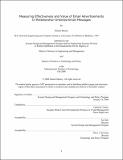| dc.contributor.advisor | Catherine Tucker. | en_US |
| dc.contributor.author | Shenoy, Dinesh (Dinesh Arkal) | en_US |
| dc.contributor.other | Massachusetts Institute of Technology. Technology and Policy Program. | en_US |
| dc.date.accessioned | 2008-11-07T14:11:28Z | |
| dc.date.available | 2008-11-07T14:11:28Z | |
| dc.date.copyright | 2008 | en_US |
| dc.date.issued | 2008 | en_US |
| dc.identifier.uri | http://hdl.handle.net/1721.1/42931 | |
| dc.description | Thesis (S.M.)--Massachusetts Institute of Technology, System Design and Management Program; and, (S.M.)--Massachusetts Institute of Technology, Engineering Systems Division, Technology and Policy Program, 2008. | en_US |
| dc.description | This electronic version was submitted by the student author. The certified thesis is available in the Institute Archives and Special Collections. | en_US |
| dc.description | Includes bibliographical references (p. 63-70). | en_US |
| dc.description.abstract | This thesis explores the value of email advertisements in relationship-based communication by measuring click-through rates. Advertisements were embedded within standard electronic mail messages in a template. The results are discussed in aggregate to better understand this medium and value in an advertising context, but the analysis also breaks down how six factors affect click behavior by recipients. The factors include the impact of a privacy statement, type of organizational recipients, click timing, recent advertisements, advertisement frequency, and advertisement relevance. The results are also analyzed using a chi-squared statistical test to determine whether the individual factor is significant in this analysis. This paper also discusses the privacy implications of advertising in a social-medium with comparisons to social ads using Facebook's Beacon as a benchmark. A discussion of how these results apply in an email environment where anti-SPAM infrastructure is a large part of the overall system is evaluated as well. Results show that internal recipients are an effective target market for relationship messaging and that emails often generate clicks days or weeks after the original message was delivered. The research is very relevant to email and targeted advertising, but also applies in a broader context to social advertising where there is a existing relationship between a sender and recipient. | en_US |
| dc.description.statementofresponsibility | by Dinesh Shenoy. | en_US |
| dc.format.extent | 70 p. | en_US |
| dc.language.iso | eng | en_US |
| dc.publisher | Massachusetts Institute of Technology | en_US |
| dc.rights | M.I.T. theses are protected by
copyright. They may be viewed from this source for any purpose, but
reproduction or distribution in any format is prohibited without written
permission. See provided URL for inquiries about permission. | en_US |
| dc.rights.uri | http://dspace.mit.edu/handle/1721.1/7582 | en_US |
| dc.subject | System Design and Management Program. | en_US |
| dc.subject | Technology and Policy Program. | en_US |
| dc.title | Measuring effectiveness and value of email advertisements in relationship-oriented email messages | en_US |
| dc.type | Thesis | en_US |
| dc.description.degree | S.M. | en_US |
| dc.contributor.department | System Design and Management Program. | en_US |
| dc.contributor.department | Massachusetts Institute of Technology. Engineering Systems Division | |
| dc.contributor.department | Technology and Policy Program | |
| dc.identifier.oclc | 251512028 | en_US |
